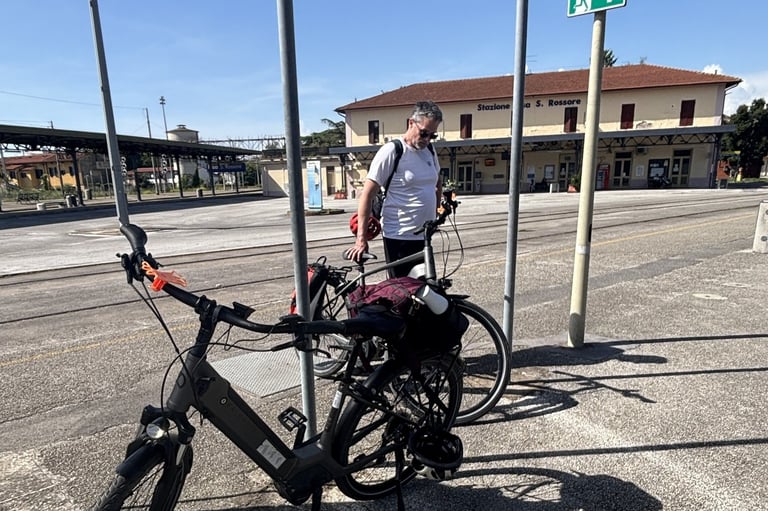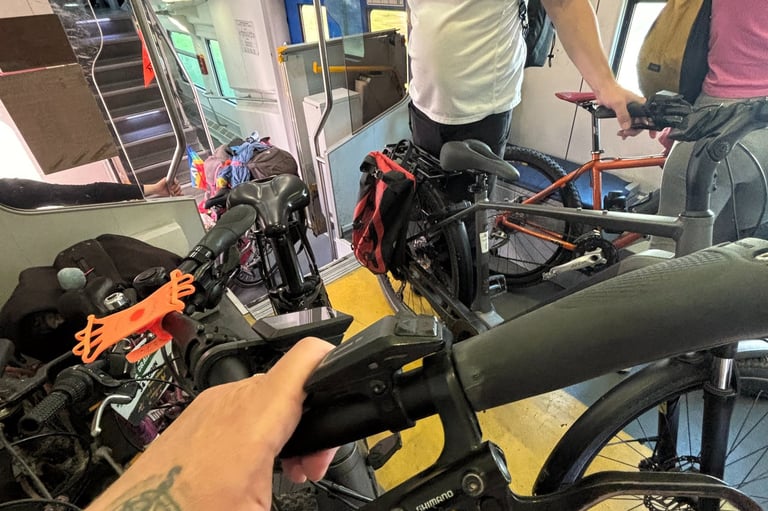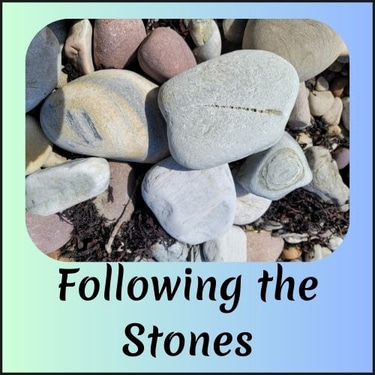Unusual Journey to Pisa, Italy
There's the easy way, and the other way.
ITALY GALLERY
6/11/20256 min read
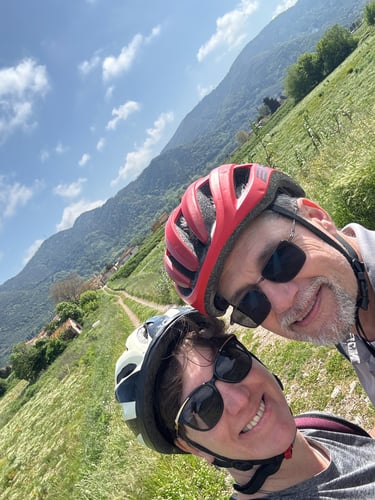

Everyone knows the town of Pisa, Italy. The infamous building can be seen in the hands of millions of visitors who captured the ionic photo of pushing the tower back into place. It seems most people visit Pisa quickly for a day trip. Their preferred methods of transportation include a formal tour from the cruise terminal in Livorno, a formal bus tour from Florence, or a train ride from any other city in Italy.
Greg and I are enjoying life differently than “most people”. Our early retirement is about the journey more-so than the destination. Therefore, we chose a distinctly different way of traveling to Pisa. We rented electric bicycles in Lucca, Italy and rode the lovely pathway between the two cities (distance 33km, cost $102 from GetYourGuide.com). This was our second touring bicycle trip together. In 2022, we had a beautiful cycle journey in Ireland from Achill Island to Westport (Distance 42km). We are not avid bike riders. We do not own cycling gear. We even have body parts that don’t move as well anymore. But cycling in nature is another way of being part of life on this planet.
Starting from the walls of Lucca, we had some city riding before we got to the gravel road that paralleled the river. The gravel road was similar to the Forest Service Roads we have at home in Washington State. Traveling along through nature throughout the midmorning was our favorite. We listened to the birds, commented on giant trees, and smelled the fresh clean air. There were only a few people along our journey.
Getting off the beaten path into the countryside often means you are following old pathways created by animals, farmers, or the adventurist. This cycling trip guided us THROUGH the farms in some sections. Being April, we had standing water and mud in numerous places. But the wildlife we saw included birds, fish, and even turtles.
Several times during the 33km ride, we had to traverse through ancient Italian towns. Darn. But the thing to understand is that 800-year-old buildings do not get moved when roads need to be installed. The roads are built right up to the front door of houses in these places. There aren’t bike paths or sidewalks. In fact, many of the roads are only about 15 feet wide (5 meters) and two miniature cars can barely pass each other. Now add a bicycle to the mix and you have some harrowing moments of “traffic” in the ancient town.
The most spectacular part of the journey (yes, better than the leaning tower) was the aqueduct park. Not only did we get to take a break and fill our water bottles from a cool park fountain, but we got to ride along the actual aqueduct built in the 1600’s by the Medici family. It is an elevated structure about 6 km long and composed of 934 arches that still exist between Asciano and Pisa, terminating at the so-called Porto delle Gondole, a basin of water still visible today from the top of the Medieval Walls. Who gets to say they touched and rode alongside several kilometers of ancient aqueduct built by hand before modern construction.
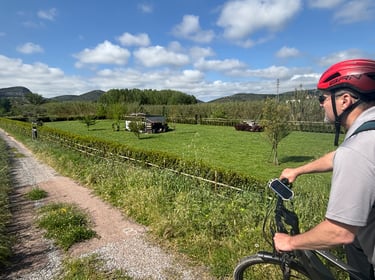

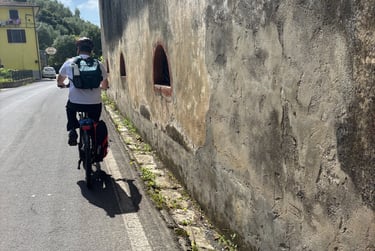

Finally, we arrived in Pisa. The sun was shining, and the crowds were thick at 3:00 in the afternoon. The journey took us longer than we expected because we kept stopping to admire the beauty around us, so our time in Pisa was limited. The bicycles were due back by 6:30 which meant we needed to use the train to return to Lucca. Given the short time, we enjoyed some time on the lawn near the leaning tower where it was allowed, and we took some pictures. We wandered The Piazza dei Miracoli, formally known as Piazza del Duomo and admired the clock tower at Infopoint turistico Pisa.
Our journey back to Lucca on the train was a bit more adventurous than the 33km bike ride. First, there are two train stations in Pisa (Pisa Centrale and Pisa Rossa). On the map Pisa Rossa seemed closer to our location, so we rode over there. This unmanned station required us to purchase tickets at the kiosk using our phone and the internet to help navigate which train had bicycles spaces and how to add that onto the people ticket we needed to buy (bikes cost an extra fee). Then we waited for the train time. Initially, there were only a few people around and it felt like a ghost town, but the platform soon became a bit crowded, and we stressed over where we needed to stand on the platform to load the bicycles into the correct train car (there is a limit of six bike spaces in the car). We began stressing with intensity when we saw CLN on the reader board next to our train number. What does that mean? A quick internet search did not provide results, but moments later we KNEW what CLN meant as our scheduled train flew past the station on the tracks without stopping.
At this point in our travels (2 weeks), we had limited experience with trains. It was time to ask for help. A kind gentleman near us had a little bit of English skills and explained that the train we wanted was running late, so they cancelled some of the smaller stops (ours!). He also reassured us that we could take the next train that came through the station using our same tickets. Minutes later, the next train appeared and stopped. Loading and offloading the bikes would have been easy if other people had hung their bikes on the rack like they were supposed to. Instead, a few bicycles were pushed in with the kickstand down and one woman had an entire travel mobile blocking the stairs for the bike rack. Her bike, travel trailer, luggage and knapsack forced us to help her move it all aside just so we could negotiate into a tight bicycle area with our bikes balanced on their back wheel. And that is where we stood for the 20-minute train ride. By now we were exhausted and filled with various emotions, but we did it. We successfully rode between two amazing towns in Italy and navigated ourselves through the Italian train system. It will forever be a great story.
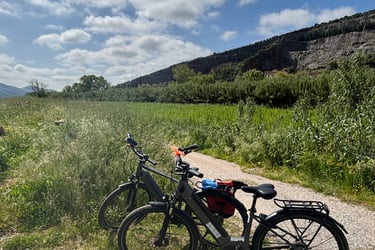

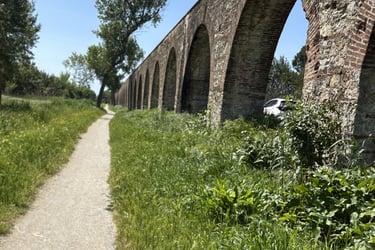

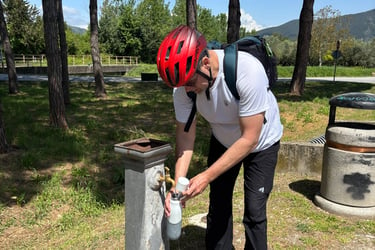

Bonus info:
We rented the bikes through Get Your Guide which then included the Kamoot travel app.
Pisa Park has clean paid toilets (€2), but only accepts credit cards
There were many posted signs about staying off the grass in front of the tower, but several bad tourists chose to ignore the clear signs.
In Italy we have had several train station stops cancelled due to route delays. Have a back-up plan. And we had one train strike. Have a back-up plan and extra funds!
Why does the tower lean? Construction on this tower, which was supposed to be a bell tower for the Cathedral of Sata Maria Assunta, began in 1173. Five years later a structural failure was discovered and work stopped for almost 100 years. In 1370, the tower was finally completed, but the tower had a measurable lean. In 1838 an architect attempted an intervention to fix the lean, but it failed. In 1934 another intervention was trialed, and it almost collapsed the tower. In the 1990’s the bell tower was closed to the public because it was in severe danger of collapsing, but restoration work and a massive ground intervention was trialed. In 2001 the tower reopened for business
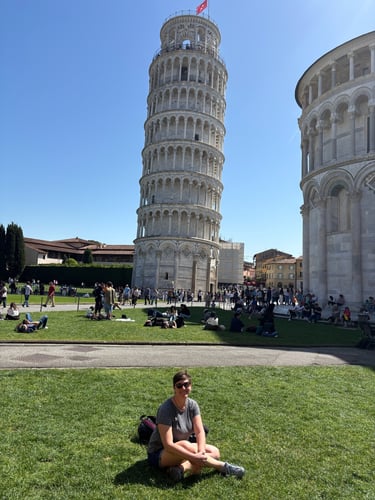

Is the journey over? NO!
